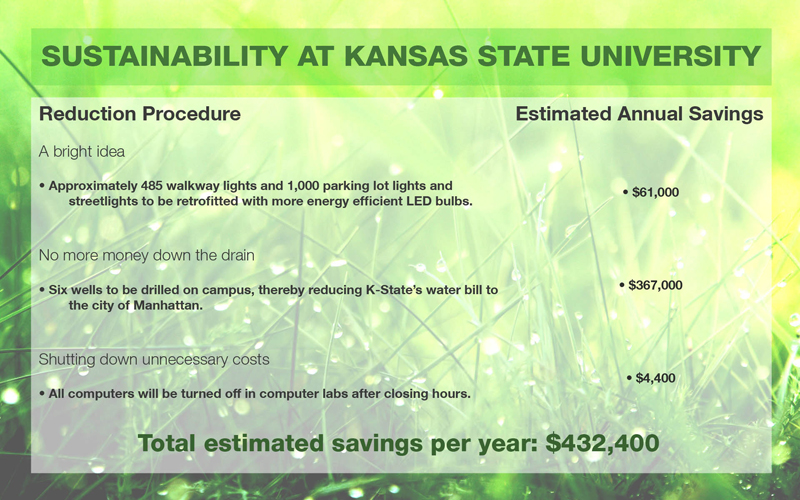K-STATE BECOMING MORE GREEN AS SUSTAINABILITY MEASURES TAKE HOLD
At Kansas State University, sustainability is more than just the latest buzzword. Several projects are now under way to make the university a greener place.
"Large university campuses are like small cities in terms of their environmental footprint and K-State is no different," said Ben Champion, director of sustainability at K-State. "If K-State is going to prepare the next generation to leave the planet in better shape than they found it, we need to be practicing what we preach on campus."
K-State made environmental, social and economic sustainability an institutional priority in 2008 and Champion is leading those efforts.
Current projects to make K-State more sustainable involve water and energy use. The K-State Division of Facilities is working with Johnson Controls, an energy service company, to plan campus infrastructure improvements that will create savings and environmental benefits.
One of the most visible projects is the installation of new lighting along campus walkways, in parking areas and outside of buildings. A total of 485 walkway lights and more than 1,000 parking and street lights are being retrofitted so that they will use energy more efficiently. For example, lights along campus walkways will now take 85-watt LED bulbs, instead of the traditional 250-watt bulbs.
"This project, which should be completed in the fall, will reduce light pollution and the amount of energy needed to provide safety lighting across campus," Champion said.
That single change is estimated to save about 1.4 million kilowatt-hours or $61,000 a year. That's a little more than 1 percent of total electricity consumption at K-State, Champion said.
K-State also is working on water issues. Six wells will be drilled on campus from which non-potable water for irrigation and the campus' steam systems will be drawn. This will save the city of Manhattan from having to provide 175,550,000 gallons of treated water a year to K-State and will reduce the university's water bill by about $367,000 annually, according to Champion. The wells will be drilled on the southeast corner of campus near the intersection of North Manhattan and Bluemont avenues; in the intramural fields at the Chester E. Peters Recreation Complex; and near K-State's baseball stadium.
In addition to saving the university money, the well project also will help the city conserve some of the capacity at its water treatment plant. Whether the city's water treatment plant is large enough to meet the needs of a growing regional population is a concern. The entire project will cost more than $3 million initially, but the return on that investment over time will be substantial, Champion said.
Among a myriad of other projects, Champion said that K-State's office of information technology services also is looking into energy-saving software for the approximately 500 computers the office manages in labs across campus. Just turning off those computers when the labs are closed will save 198 kilowatt-hours a year per computer, or approximately $4,400 a year, Champion said.
"We use a lot of energy and resources on campus and a lot is wasted. There are thousands of little and big ways we can reduce that waste. We will see more efforts like this on campus in the future," Champion said. "Saving energy and water are crucial ways for us to do our part in being responsible stewards of our resources and working toward a sustainable future."
Other future projects include converting the former wind erosion laboratory space into the campus recycling center in the next 18 months, and campus officials also will be examining the possibility of a single-stream recycling system and starting a surplus materials program for the entire K-State campus.
"Societywide, these kinds of efforts might buy us enough time and money to figure out how to run our lives on renewable resources instead of finite ones," Champion said.
K-State consumed 121,890,146 kilowatt-hours of electricity and 731,793 thousand cubic feet of natural gas in 2009, which amounts to $16 million in utility bills and around 195,500 metric tons of carbon emissions. That's $700 or 8 tons of carbon emitted per K-State student.
More information about K-State's sustainability efforts is available at http:www.sustainability.k-state.edu.
